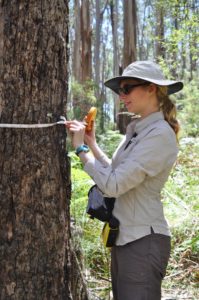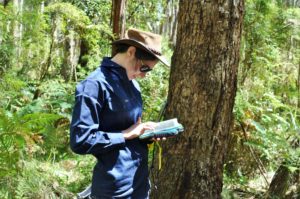Understanding koalas, stress and habitat declines
Founded by the Zeno Karl Schindler Foundation and supported by the University of Queensland, a very important scientific project is underway at the Conservation Ecology Centre.
 As koala habitat continues to decline we are continuing to work towards a a better understanding of the situation in order to contribute to future management.
As koala habitat continues to decline we are continuing to work towards a a better understanding of the situation in order to contribute to future management.
Supervised by Professor Clive McAlpine and the research team at the CEC, Dr Manuelle Cottin and Research Assistant Nicole Davies will be collecting data during the next month, both at CEC and across the neighbouring woodlands, both on private land and through the Great Otway National Park. By collecting data on the condition of koalas and of their trees, researchers will be able to gain more knowledge on the diet and the stress levels of koalas in different habitats.
 More news about the results of this study soon!
More news about the results of this study soon!
Thanks to support from the Norman Wettenhall Foundation this three year Biodiversity Monitoring project will allow the Conservation and Research Team at the Conservation Ecology Centre to survey the animals found in the declining manna gum habitat.
During the first phase of the project, ecologists are surveying small mammals, reptiles and amphibians, but further research includes surveys of birds, bats and some larger mammals. Crucial plant research will assist with understanding the links between plant and animal diversity, so that biodiversity losses can be avoided.
Manna gum woodlands have been in decline in the area over the past decade and research is critical to inform decision-making for their conservation. While the Conservation Ecology Centre Conservation and Research Team have been monitoring manna gum decline, it is also important to examine how the trees’ decline will affect other species. With such drastic decline, there is likely to be some connection between mature tree loss and loss of animal diversity. Conservation and Research Manager, Dr Jack Pascoe, and Researcher, Marika van der Pol, are working on pinpointing this critical threshold so it can be used as a gauge for habitat health. Conservation and restoration efforts can then be focused more effectively. A certain density of mature trees is likely to be important for woodland health; once the threshold is identified land holders and managers will be able to develop management strategies to keep the density of mature manna gums at or above a certain level, thus stopping the decline of animal diversity. The ultimate goal of the Conservation Ecology Centre’s research team is to make informed decisions about landscape scale revegetation and habitat rehabilitation programs at Cape Otway and beyond.
Why is there a need for Conservation Dogs in the Otways?
The Tiger Quoll is the largest remaining carnivorous marsupial on the Australian mainland. It is an endangered species and is declining across its entire range, even in the Otways which was once a key habitat for the Tiger Quoll.
One great way for detecting an elusive animal while causing minimal impact is through finding scats (poos). Scats contain DNA fragments and these can be extracted and analysed to gain insights into the population through a better understanding of their genetics.
Until 2012 there was no confirmed evidence of Tiger Quoll presence in this region for nearly a decade. This year the Conservation Ecology Centre discovered scats of two different Tiger Quolls in different areas of the Otways. Both these scats were discovered by chance and you can read more about each discovery here. Dogs have highly sensitive noses and can be trained to find a target scent – through teaming up with man’s best friend we can greatly increase the efficiency and effectiveness of our detection efforts.
Who are the Otways Conservation Dogs?
The project is led by the Conservation Ecology Centre, working in collaboration with Canidae Development* and the 2012 program has been proudly supported by the Mazda Foundation.
The team is comprised of canine volunteers from our community and their people – an incredible group who are working together, learning from one another and contributing to the conservation of the region.
How do you make sure the Quolls are not affected by the dogs?
We are working in very environmentally sensitive areas and are careful to minimise the impacts of our activities. Otways Conservation Dogs are trained to find the evidence of Tiger Quolls not the animal itself; in this case we are searching for Tiger Quoll scat (poo). Our training is about detection and the dogs are trained to perform a passive alert behaviour of dropping (or sitting for the very little dogs in the team!) on locating a scat sample. There is absolutely no barking, scratching or digging and the dogs do not interact directly with the scent source.
Highly trained dogs and handlers are assessed according to strict criteria for operational readiness. When dogs are operational they are deployed according to protocols under the direction and supervision of a Conservation Ecology Centre representative.
Otways Conservation Dogs are taught not to be distracted by other animals as part of their training – our dogs are not allowed to chase any animal at any time (this includes wildlife, domestic and pest species). In fact, our dogs are so well trained around wildlife that the wild kangaroo mob often hangs around on a Sunday morning to watch our training sessions!
What sorts of dogs make good detection dogs?
 Our team comprises a wide range of dog breeds and personalities – from gutsy Jack Russels and happy Bishon Frise to eager German Shepherds, conscientious Australian Shepherds, delightful Golden Retreivers, smiley Spaniels, focused Kelpies and bouncy Border Collies – to name a few!
Our team comprises a wide range of dog breeds and personalities – from gutsy Jack Russels and happy Bishon Frise to eager German Shepherds, conscientious Australian Shepherds, delightful Golden Retreivers, smiley Spaniels, focused Kelpies and bouncy Border Collies – to name a few!
Our skilled instructor from South West Victorian Dogs brings out the very best in each dog/handler team, working together with everyone to find the training approach which best suits each combination. We have seen incredible advancements in every single member of the team – both human and canine.
Our team members live both locally and quite far away, with some members rising at 4am to make our Sunday morning training sessions.
How can I get involved?
The project is currently running at capacity, however, if you are interested in getting involved we welcome you to get in touch via our contact form and we can discuss the opportunities for the future. There are certainly ways to get involved with this project even if you don’t have a dog!
 Learn more about Tiger Quolls.
Learn more about Tiger Quolls.
Learn more about the Tiger Quoll Conservation Program.
Read up on the Conservation Ecology Centre’s 2012 discoveries of Tiger Quolls in the Otways – the Eastern Otways scat and the Cape Otway scat.
Learn more about the Otways Conservation Dogs Project.
*We began working on this project with South West Victorian Dogs but Luke Edward’s work has quickly outgrown the scope of the SWVD organisational structure. Canidae Development was launched in July 2013 and we are delighted to have been able to witness this evolution – it is an exciting time for dogs in conservation.
